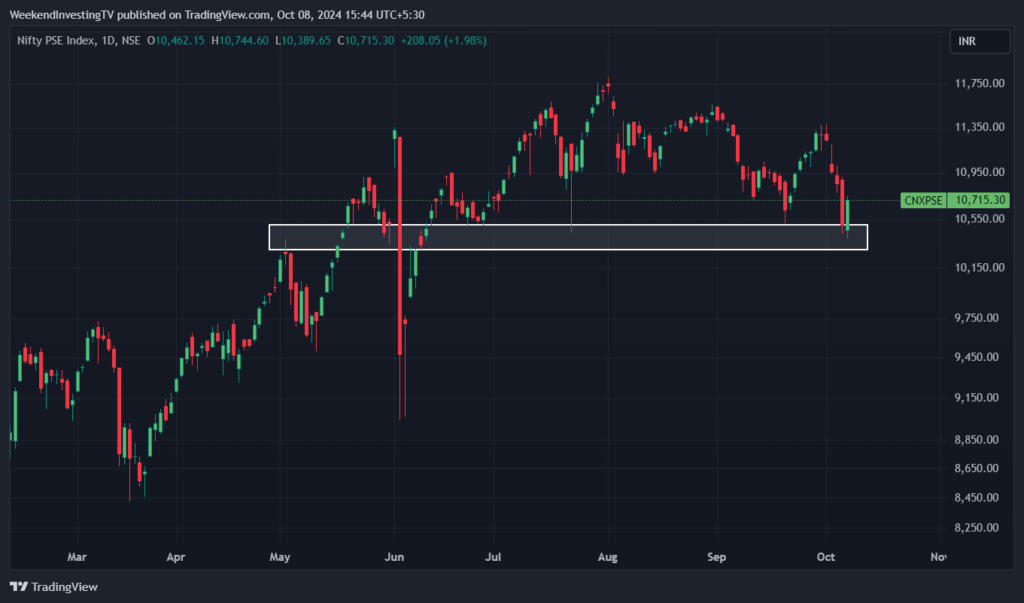
Another surprise day—like yesterday’s unexpected down move, today brought a surprise on the up move. We can attribute this upturn to various factors: perhaps a shocking reversal of election results in Haryana, or the significant downturn in the Hong Kong market, leading FIIs to reduce their outflow from the Indian market. Alternatively, it could simply be a bounce from the recent lows after four or five days of drubbing. Regardless of the reason you choose to emphasize, the markets performed well today.
In the second half, we will discuss whether we should sell based on news.
Where is the market headed?
Market Overview
As we mentioned yesterday, we were nearing a support point, and now we’ve made a solid bounce of 0.88%. However, we are still not out of the woods by any stretch of the imagination; the trend remains down. If we can maintain levels above this moving average and the two-day high of around 25,200, we may start to see more stability.
There is also a possibility that Nifty might bounce back to the average and then fall again, potentially completing a head and shoulders pattern before dropping to lower levels. All these scenarios remain open, but it’s a positive start to the bounce. Any upward movement after a decline often resembles a dead cat bounce. For instance, after four or five sessions of decline, the rise can seem vulnerable, as we witnessed previously when the market had a down day after two sessions of gains. Nevertheless, it recovered on the subsequent side.
In this context, the 25,176 level or thereabouts will be a critical decision point for the market.

Nifty Next 50
Nifty Junior also made a strong comeback, rising 2.35% and effectively erasing all of yesterday’s losses, returning near the average again. This bounce was sharp, but down moves typically lead to quick recoveries. Thus, it’s premature to declare that the worst is over until we cross a more stable line.

Nifty Mid and Small Cap
Mid caps are performing better, up by 1.98% and comfortably above 21,600. Small caps also found good support at this gap level and bounced back, showing a gain of 2.1%. While this could still be a dead cat bounce or a reversal, we will only know after a few days.


Nifty Bank Overview
Bank Nifty experienced a modest bounce, resulting in a completely inside day. Until we surpass 51,730, we cannot draw any conclusions. However, the fact that we didn’t drop lower is a relief. Still, it could indicate a downward trend if we breach yesterday’s low. For most charts, yesterday’s low has become the most important technical point; if we fall below it, the bulls will likely grow nervous again.

Advanced Declined Ratio Trends
Today’s market saw 413 advances against 87 declines—a remarkable reversal from yesterday’s 450 to 50. This change is notable, especially considering the FIIs’ cash outflow of 8,200 crores. In contrast, DIIs injected 13,000 crores into the market, driving delivery-based transactions and effectively purchasing whatever FIIs sold. Typically, transactions between FIIs and DIIs are cross transactions; thus, one party sells while the other buys, making it a seamless exchange between the two.


Nifty Heatmap
Today’s heat maps were largely green, with HDFC Bank and Reliance leading at 2% each. Mahindra and Mahindra surged 3.5%, surprising many as stocks entering the Nifty typically see subdued performance. However, both Trent and Bel witnessed significant upward movements of 8% and 5%, respectively. Adani Enterprises and Adani Ports also rose nearly 5%, while L&T was up 2%, and Coal India and Bajaj Auto gained 2.3%. On the other hand, there were some slippages in the banking and finance sectors, with Titan losing ground. JSW and Tata Steel stocks are currently in a state of confusion, uncertain whether to follow the Indian or Chinese trends.
Nifty Next 50 showed even more green. This index often reflects a higher beta of Nifty, with stocks that plummeted yesterday—like IRFC, PFC, REC, Zomato, and HAL—performing well today. ABB, Siemens, and others in the capital goods sector also rallied, with Varun Beverages soaring 9% after a tough day.


Sectoral Overview
Sectoral indices were generally up, except for metals, which face unique circumstances regarding the Chinese and Indian markets. The FMCG sector showed minor gains of half a percent, while public sector enterprise stocks rebounded significantly, up 2%. Autos rose by 1.7%, and energy infrastructure and consumption also gained over 1.5%. Interestingly, pharma stocks increased by 1.4%, with the sector seeing its fourth or fifth segment in the green for the month. Metals lead on a monthly basis, alongside consumption and auto stocks, which are performing well on a week-to-week basis. So far, pharma is the only sector that has moved into positive territory, while the others remain in the negative over the past week.

Sectors of the Day
Nifty PSE Index
Yesterday and today established a critical bottom for public sector enterprise stocks. Had this bottom broken, we might have revisited previous lows, but today’s bounce has been significant. Stocks like Power Finance, IRFC, and HL have performed well within this sector.

Stock of the Day
PAYTM
Paytm showed a remarkable turnaround after yesterday’s decline, surging 15% today. There has been a continuous rally for Paytm over the last six months, although some investors are still stuck at higher prices. Nevertheless, this trend of recovery on up days is encouraging. Phenolx Industries, as we noted yesterday, has also shown strong performance over the month.

Story of the Day

Often, people react to news they encounter—whether in print, online, or on TV—believing it to be fresh and exclusive information. This is a common mindset among novice investors. However, it’s important to understand that many people are often aware of this information before it becomes public. For instance, in the case of a company acquisition, teams from both companies have been negotiating for months, so the involved parties are well-informed long before any public announcement. To assume that you are the first to react to this news is naive. Typically, such news is already discounted by the market.
For example, consider Ola Electric, which listed at Rs. 76 and saw a surge of 100% amidst discussions of becoming a potential multibagger. Eventually, the stock started to decline, reflecting the reality that the market had already adjusted to the situation. Interestingly, on days when negative news surfaced, the stock price could still rise, illustrating how reactions may not align with the news itself because the information was already known to the broader market.

Today’s election outcome was initially discounted in favor of the Congress, leading to a market decline in previous days. However, today’s reversal resulted in a relief rally. If the Congress had won but the market remained flat, there would have been little reason to sell. The dilemma lies in whether the news or events have already been discounted, which is often difficult to determine. If a stock moves from 100 to 150, with new news coming out, predicting whether it will climb to 200 or drop to 120 is a complex challenge. The valuation could fluctuate significantly, and thus relying on trend-based analysis is essential.

In the case of Ola today, a significant movement creates a dilemma for investors. They must decide whether to hold, allocate more, or exit based on their original rationale for investment. As the market is flooded with positive and negative news, making discretionary decisions can become challenging. Often, when stocks crash or surge based on news, they may already be reflecting the market’s sentiment or the insiders’ knowledge of the situation. Thus, it becomes crucial to establish a framework that allows for trend-following strategies rather than reacting impulsively to news.
This non-discretionary approach means not trying to predict or assess whether a stock will rise or fall based on news. Instead, investors should adhere to a structured plan based on market trends. If a stock price falls below an exit point, regardless of the accompanying news, investors should sell. Conversely, if a stock rises in value due to positive news, and it aligns with their buying criteria, they should proceed without overthinking the news aspect. Such an approach minimizes emotional biases and enhances the effectiveness of investment strategies.









